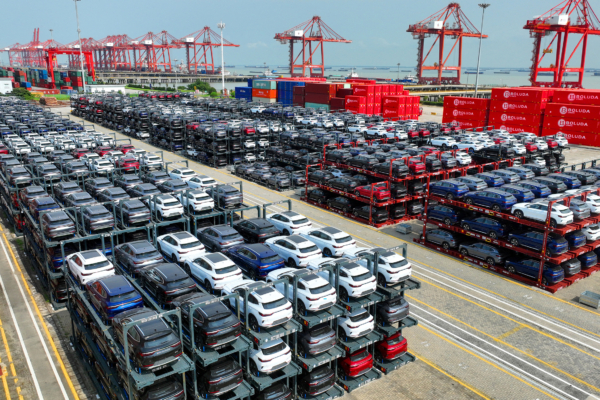In China, the development of new energy vehicles (electric cars) has been rapid, but they are facing widespread questioning not only in terms of safety but also in terms of environmental friendliness and technological aspects.
Chinese automotive industry expert Huang Guocheng bluntly stated: The promotion of new energy vehicles by the Chinese Communist Party is actually a false proposition, as it is neither environmentally friendly nor cost-effective. It also brings risks of battery radiation and occupational diseases. He pointed out that the authorities, unable to compete with foreign capital in the traditional automotive field, have resorted to creating a gimmick.
Huang Guocheng, who graduated from university in 2004 and worked for a well-known Chinese car company, has been involved in the research and development of core components of new energy vehicles since 2011. In a recent interview with the press, he asserted that the overall technological level of Chinese new energy vehicles currently only ranks in the “second tier” globally and cannot be compared with leading international brands like Tesla.
According to Huang, the majority of new energy vehicles in China are still mainly imitating Tesla, showing significant gaps not only in battery technology but also in overall vehicle safety.
He cited incidents of self-ignition involving domestic brands like BYD, indicating clear shortcomings in battery management systems and material control.
In recent years, Chinese new energy vehicle giant BYD has experienced multiple fire incidents, causing widespread concerns.
Huang Guocheng analyzed that many Chinese brands resort to “reverse engineering” methods, such as purchasing Tesla vehicles for disassembly in an attempt to replicate their designs. He explained that Tesla’s real-time monitoring of voltage and temperature for each battery module is a technology that China still struggles to fully replicate.
With China’s assistance, Tesla established a super factory in Shanghai in 2017 and received 20 billion RMB in bank financing under the condition that 100% of the supply chain components must come from China.
Externally, China has seen a proliferation of electric vehicle companies copying Tesla without intellectual property constraints, resulting in overcapacity and price wars, ultimately denting Tesla’s market share in China.
Despite the extensive promotion of electric vehicles by the Chinese government, claiming dual environmental and economic advantages, Huang Guocheng has raised strong doubts.
While acknowledging that electric cars can reduce operating costs in the short term, he pointed out that the limited lifespan of batteries becomes a fatal flaw in the long run.
Currently, batteries can only support around 3000 charge-discharge cycles on average, necessitating replacement every 5 to 6 years, with battery costs accounting for about two-thirds of the vehicle price, making a battery replacement almost equivalent to buying a new car.
Regarding environmental concerns, Huang asserted that new energy vehicles are a “false proposition.” With over half of China’s electricity still coming from coal, electric vehicles merely shift pollution from tailpipes to power plants.
Furthermore, the disposal of lithium batteries, which typically have a lifespan of 5 to 10 years, leads to a significant problem of waste. Reports from the Yano Research Institute in Japan in 2021 indicated that China accounted for 94% of global battery waste.
These discarded batteries contain hard-to-decompose chemicals, posing long-term pollution risks to soil and water resources, potentially surpassing the environmental damage caused by carbon dioxide emissions.
Huang Guocheng also mentioned the emerging issue of battery radiation with new energy vehicles.
He noted that prolonged exposure to electromagnetic radiation from batteries under seats or in the rear of vehicles has led to symptoms like neck problems, hair loss, and dizziness among long-term electric vehicle drivers, suggesting potential health risks.
He predicted that with accumulated experience and increased market awareness, China’s new energy vehicles will eventually hit a developmental bottleneck. Without significant technological breakthroughs, the industry’s pursuit driven by novelty and subsidies may not be sustainable.
Amidst a multitude of drawbacks, why does the Chinese authorities continue to push the new energy industry? Huang candidly stated: Chinese brands are unable to compete with foreign capital in the traditional auto sector.
The rationale behind this push, according to Huang, is a politically driven industrial strategy aimed at attracting capital and consumer attention through new concepts in an attempt to gain a foothold in the global auto market.
However, he emphasized that this approach is a way to deceive people who are not knowledgeable about cars, essentially using taxpayers’ money for experiments.
In conclusion, Huang Guocheng advised Chinese consumers: When selecting vehicles, prioritize safety and practicality over flashy appearances or decorations.
He urged people to consider safety more when choosing a vehicle, emphasizing the importance of valuing one’s life above entertainment-focused designs often seen in many domestic electric cars.
Huang Guocheng left China in March 2024, arriving in the United States through indirect means, and continues to monitor the development of China’s automotive industry. His observations and criticisms provide valuable firsthand reflections on the feasibility and real effects of current Chinese new energy policies.

